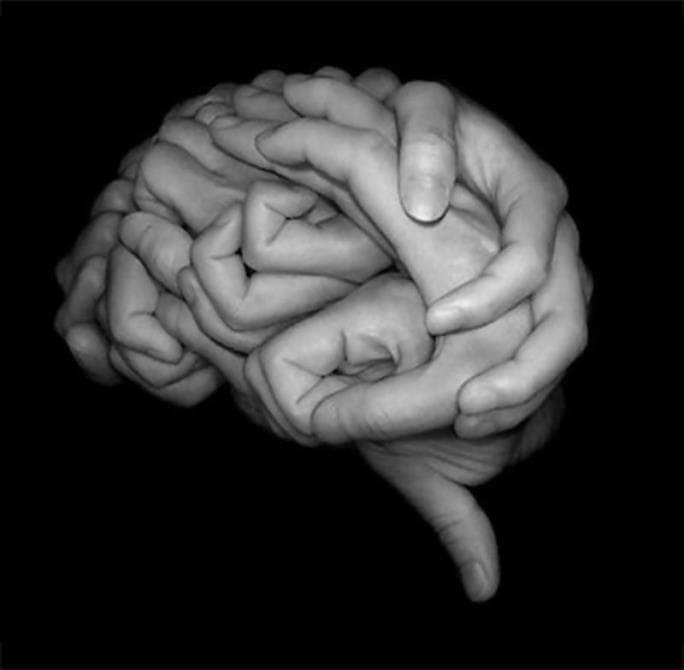Brain plasticity and phantom limbs: Does amputation rewire the sense of touch?

In October 2015, 28-year-old Nathan Copeland used a robotic prosthetic arm to give President Obama a fist bump at a scientific conference in Pittsburgh. Copeland, who was paralyzed from the chest down in a car accident in 2004, also showed the President how he could "feel" with the hand, which sent realistic sensory feedback through electrodes implanted in his brain.
It was a feat of engineering and neuroscience by a team of researchers from the University of Pittsburgh and Sliman Bensmaia, associate professor of organismal biology and anatomy at the University of Chicago — and a feat that was made possible by the resilience of the sensory parts of the brain.
Bensmaia has spent years researching how the nervous system interprets sensory feedback as we touch or grasp objects, move our limbs and run our fingers along textured surfaces. He believes that the best way to restore the sense of touch in patients like Copeland is to use a "biomimetic" approach that mimics the natural, intact nervous system. By studying how the brain normally encodes and responds to sensory information, scientists can reproduce those signals through a prosthetic limb connected directly to the brain.
This approach assumes that the part of the brain responsible for processing the sense of touch, the somatosensory cortex, is relatively stable-i.e., that if someone loses a limb or becomes paralyzed, the somatosensory cortex is still there, intact and ready to respond to stimulation. But Bensmaia says that every time he gives a presentation about his prosthetics research, someone invariably challenges him with a different idea-that after amputation, the brain reorganizes and uses that part of the somatosensory cortex for something else.
This notion was popularized by a series of famous studies in the 1990s by V.S. Ramachandran at the University of California, San Diego. Three amputees reported that when they were touched on the face, they felt sensations that corresponded to their missing, or "phantom" hand. This curious phenomenon was taken as direct evidence for brain reorganization–once input to the brain territory of the (now missing) hand is lost, this territory is claimed by the face.

Ramachandran went on to become a popular scientific speaker and author of several books, most notably Phantoms in the Brain in 1998. His ideas added to a broader school of thought on the brain's "plasticity," or ability to change and accommodate for learning new skills or responding to trauma like losing a limb. This supposed malleability is what troubled Bensmaia.
"If the somatosensory cortex were so labile, then the biomimetic approach wouldn't work," he said. "Instead, the design of the neural interface would depend on the idiosyncratic neural representations of each individual, rather than based on general principles of organization, which we work to uncover."
In response, he teamed up with Tamar Makin, an associate professor at the University of Oxford, United Kingdom, and an expert on the brains of amputees, to write a paper that challenges the notion of massive reorganization of sensory representations in the brain after amputation. Based on a reexamination of the existing literature and on their own work, Makin and Bensmaia argue that while other parts of the brain may indeed be plastic, the somatosensory cortex for processing the sense of touch is relatively stable.
"Previous researchers studying amputees focused on representations of body parts that are not directly affected by the amputation, such as the face, to study brain plasticity," Makin said, but she thinks this is just one piece of the puzzle.
"Amputees ubiquitously report very vivid sensations of their missing hand, called 'phantom sensations.' In my research, we take advantage of this remarkable phenomenon to study the persistent representation of the missing hand," she said.
For instance, the body parts that are thought to benefit from the brain resources previously devoted to the missing hand do not gain any functionality by having access to that additional sensory processing power. In experiments, the skin surfaces of the face that trigger these sensations are no more sensitive to touch than before amputation.
Second, as in Bensmaia's research, both amputees and paralyzed patients like Copeland reported realistic, natural-feeling sensations in their missing or otherwise insensate arm when stimulated through residual nerves or directly in the brain. This suggests that the portions of the brain responsible for that arm are still there, ready and waiting for sensory input from the arm.
"Even if they haven't had an arm for 10 years, the way they report it is not as a phantom or vague sensation of the arm. They would describe it as, 'My arm is still present. I can't see it. I know it's not really there, but it feels like it's there,'" Bensmaia said.
Instead of the somatosensory cortex reorganizing and creating a new representation of the face, Bensmaia and Makin point to research showing that new nervous system circuits develop in the brain stem. After loss of input from the hand following amputation, parts of the brain stem that used to carry signals from the arm form new connections to neighboring areas, which can result in receiving input from a new source, like the face. However, the hand sensations generated by touching the face result from echoes of this new input, reverberating through the hand portion of the somatosensory cortex.
Bensmaia acknowledges that much of the brain is plastic of course, but suggests that we should have a more nuanced view of plasticity than is often taken for granted in the public imagination.
"You can learn how to play guitar, for example, even as an adult, so that implies that the motor parts of your brain can learn and are plastic," he said. "And right next to these motor regions, you have somatosensory regions that are relatively fixed, at least in their coarse organization. This region carries the ground truth of what your body is doing at any time."

